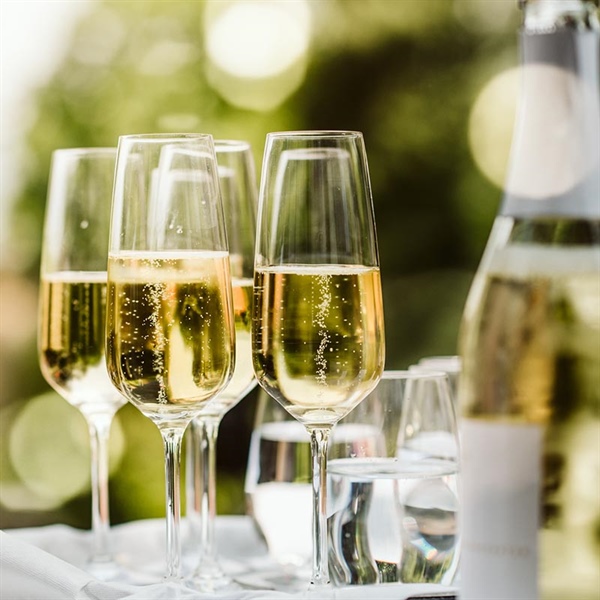By Nan McCreary
Nothing says celebration like “bubbles”. Whether it’s an engagement, a wedding, the birth of a child or a job promotion, any celebratory event is an occasion to bring out the bubbly.
Now-a-days, we are seeing corks being popped not just for special occasions, but for all occasions, be it as an aperitif, a pairing to a meal, a palate cleanser or just because. While all sparkling wines have bubbles – all bubbles are not alike.
Here is a primer on the sparkling wines we are enjoying today:
Champagne
This is the crème de la crème of bubblies and was associated with royalty in the 17th, 18th and 19th centuries. It’s no wonder. The drink is glorious, and the bubbles are exquisite. Champagne is typically a blend of Chardonnay, Pinot Noir and Pinot Meunier grapes that undergoes a second fermentation in a sealed bottle, known as the “methode champenoise” or the “traditional method.” It is illegal to label any product Champagne unless it comes from the French region of Champagne and is produced under the rules of the appellation. Champagne’s unique character comes from aging on the lees (dead yeast cells remaining after fermentation, which presents flavors of brioche or biscuit).
Champagne is considered by many to be the highest-quality, longest-lived and most complex sparkling wine in the world. The 2020 Rodeo Uncorked!® International Wine Competition affirmed Champagne’s appeal when it named France’s Piper-Heidsieck Brut, Champagne, NV the Grand Champion Best of Show. And Lily Bollinger of the House of Bollinger Champagne described our love of Champagne in this quote: “I drink Champagne when I’m happy and when I’m sad. Sometimes I drink it when I’m alone. When I have company, I consider it obligatory. I trifle with it if I’m not hungry and drink it when I am. Otherwise, I never touch it — unless I’m thirsty.”
Crémant
Crémant is any French sparkling wine made with the methode champenoise that isn’t actually made in Champagne. Crémants can be made in seven regions in France: Crémant d’Alsace, Crémant de Bordeaux, Crémant de Bourgogne, Crémant de Die, Crémant du Jura, Crémant de Limoux and Crémant de Loire. Each region has its own specific rules concerning grape varieties and maximum yields but while guidelines may be more relaxed than those for Champagne, some Crémants can be just as delicious – plus they offer great value for the money.
Prosecco
Ah, Prosecco, that glorious and inexpensive sparkler that many consider “breakfast wine!” because it’s often an ingredient in Mimosas. Prosecco is made primarily with the Glera grape in Northeast Italy. It differs from Champagne in the way it is produced. While champagne undergoes the second fermentation in the bottle, Prosecco fermentation happens in a pressurized stainless steel tank. This is known as the tank method, or Charmat Method, Metodo Italiano, Cuvée Close or autoclave. The tank method is cheaper, and less labor intensive than the traditional method. Typically, Prosecco is crisp, fresh and fruity without the nuance of biscuit or brioche found in Champagne. The best Proseccos come from the Conegliano Valdobbiadene region, where grapes are grown exclusively on the hills.
Cava
Cava is Spain’s gift to the sparkling wines of the world. Cava is made from three local grapes: Macabeo, Parellada and Xarel-lo.
Cava, like Champagne, is made in the traditional method, with second fermentation in a bottle. Because both are subjected to high pressure, they will present fine and persistent bubbles. Prosecco, by comparison, is made under slightly lower pressure and has lighter and less persistent bubbles. Cava has citrus notes and hints of pear or quince with more savory mineral flavors and less fruitiness. Cavas are aged a minimum of nine months on the lees, which produces a distinctive toasty, nutty, or even cheesy aroma. Like Prosecco, Cava is a less expensive alternative to sparkling wines than Champagne. If you’re interested in trying a Cava, pick up a bottle of Freixenet Cordon Negro Brut, Spain, NV, which was named Top Sparkling Wine in the 2020 Rodeo Uncorked!® International Wine Competition.
Franciacorta
Franciacorta is one of Italy’s best kept sparkling wine secrets. It’s named after the region where it’s made in the district of Brescia in Lombardy. It’s located in northern Italy, with Chardonnay and Pinot Noir grapes and properties of Pinot Blanc. Franciacorta is produced in the traditional method, receiving its bubbles from secondary fermentation in a sealed bottle. Because of the unique microclimate, which is much warmer than France’s Champagne region, the fruit is riper and fuller, resulting in a sparkler that is fruiter and less acidic. Wines are aged on the lees for a minimum of 18 months, which adds a deeper, more complex flavor profile. Franciacorta is among the most expensive Italian sparklers, though it never reaches the price levels of the best Champagnes.
These sparklers are the most popular types, though there are many others. Of note are those new world sparkling wines produced in the “methode champenoise” in the U.S., South America and Australia.
Napa Valley, for example, is home to many, including those produced by French Champagne Houses Moet & Chandon (Domaine Chandon), Tattinger (Domaine Carneros) and G.H. Mumm (Mumm Napa).
Remember, not all sparklers are created equal so you have lots of options. Also, don’t forget that sparkling wine isn’t just for occasions, it can be the occasion.


